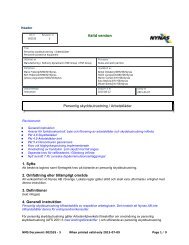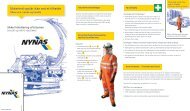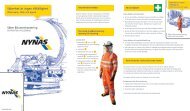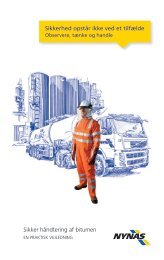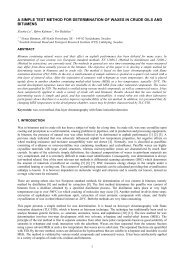High Resistance Polymermodified Binders to Secure ... - Nynas
High Resistance Polymermodified Binders to Secure ... - Nynas
High Resistance Polymermodified Binders to Secure ... - Nynas
You also want an ePaper? Increase the reach of your titles
YUMPU automatically turns print PDFs into web optimized ePapers that Google loves.
3.2 Application Example Bus Station<br />
Due <strong>to</strong> the good experiences of the high resistance PmB the Nypol 25 HR was also<br />
used for the remediation of several areas of the bus station in Hamm (Germany). The<br />
old areas made out of asphalt around the central platform had huge deformations<br />
and had <strong>to</strong> be rehabilitated.<br />
The old asphalt binder course and the old s<strong>to</strong>ne mastic asphalt were participating in<br />
the huge deformations. The optical impression of the whole Bus Square should not<br />
be changed, i.e. other constructions like concrete or composite pavement structures<br />
was not possible. The rehabilitation had <strong>to</strong> be done in an asphalt construction. After<br />
milling of the both old layers a new construction with binder course asphalt 0/22 S<br />
and with s<strong>to</strong>ne mastic asphalt 0/11 S by using the Nypol 25 HR was build. In the<br />
following table 4 the results of the wheel tracking tests are shown. The results are<br />
extremely good compare with the German limit of 3,5 mm for binder courses. The rut<br />
depth for the surface course is below 1,0 mm.<br />
Table 4: Results of German Wheel Rutting Test – Nypol 25 HR (Steel Wheel at 50 °C)<br />
Binder Course<br />
Asphalt 0/22 S<br />
S<strong>to</strong>ne Mastic<br />
Asphalt 0/11 S<br />
Binder Content<br />
[M.-%]<br />
Air Void Content<br />
[Vol.-%]<br />
Rut Depth at 50 °C<br />
[mm]<br />
4,2 6,3 2,2<br />
6,8 4,2 0,8<br />
The paving of the asphalt mixtures were made with a conventional paver by using a<br />
9,5 t smooth-wheeled vibration roller. The compaction was controlled with a Troxler<br />
probe. Due <strong>to</strong> the good workability of the HR PmB paving temperatures between 160<br />
and 170 °C were used without any problems for the compaction of the asphalt<br />
mixture. The demand compaction degree of 97 % was achieved. The laying was<br />
done during the hot summer period in August 2004. Referring <strong>to</strong> this the Bus Square<br />
was closed for three days <strong>to</strong> guarantee the cooling down. On Monday morning the<br />
bus traffic started again.<br />
4. Conclusions<br />
Based on the experiences of the high resistance high polymermodified binder is<br />
resulting that with the Nypol 25 HR and the Nypol 45 HR two binders are available<br />
which are able <strong>to</strong> ensure durable asphalt pavement for different applications.<br />
The range of plasticity of these high resistance binders amounts nearly 100°C. The<br />
heat stability amounts more than double measured by complex shear modulus and<br />
compared with a standard PmB. The behaviour at low temperatures is not affected<br />
measured with the Bending Beam Rheometer. The asphalt performance for binder<br />
course asphalt and s<strong>to</strong>ne mastic asphalt tested with the wheel-rutting tester (steel<br />
wheel at 60°C) is exceptional well.<br />
5. References<br />
Barth, R.: Das <strong>Nynas</strong> - Spezialbindemittel für sehr hoch beanspruchte Verkehrsflächen,<br />
Performance, Issue 3, 2003



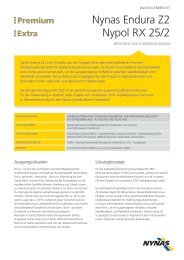
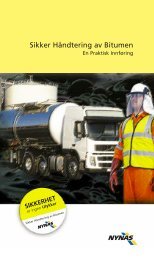

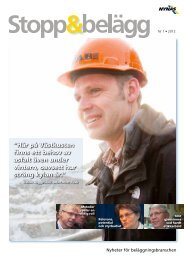
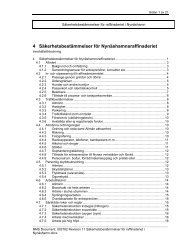
![Säkerhetsbestämmelser Gbg rev 5.ppt [Compatibility Mode] - Nynas](https://img.yumpu.com/18742268/1/190x146/sakerhetsbestammelser-gbg-rev-5ppt-compatibility-mode-nynas.jpg?quality=85)
